CONVERSATIONS WITH SAI – PART Twenty Four
CONVERSATIONS WITH SAI – PART Twenty Four
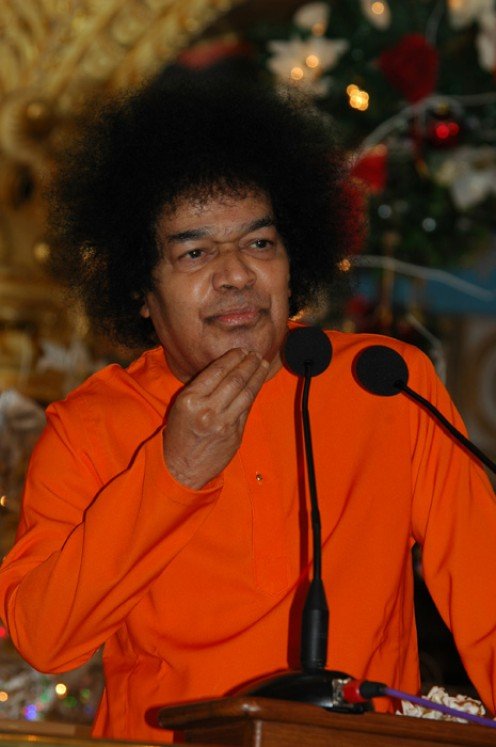
A Visitor: These miracles that Swami does by moving His hand and out come very costly things from nowhere. Is there some explanation?
SAI: Some objects Swami creates in just the same way that He created the material universe. Other objects, such as watches, are brought from existing supplies. There are no invisible beings helping Swami to bring things. His sankalpa, His divine will brings the object in a moment. Swami is everywhere. His creations belong to the natural unlimited power of God and are in no sense the product of yogic powers as with yogis or of magic as with magicians. The creative power is in no way contrived or developed, but is natural only.
H (Hislop): Is it true that wild animals will not harm a saintly person?
SAI: There was once a guru who told his disciple that God was in everything. The disciple believed the statement. That very day there was a royal parade. The king was the centre of attraction riding on an enormous elephant. Ignoring the rules of safety for such parades the disciple planted himself firmly in the path of the royal elephant, and he paid no attention to the cries of warning that he would be trampled to death. Upon reaching him, the elephant lifted him and put him safely to one side.
The disciple went to the guru and complained that although God was in both the elephant and himself, he had been unable to remove the elephant from his path. That on the contrary, the elephant had removed him. The guru explained that it was merely a matter of the elephant having greater physical strength. He told the disciple that had he not been looking at God in the elephant the beast would have killed him just as a matter of ordinary work.
However, since the disciple was looking at God in the elephant, God had safely lifted him out of harm’s way. No animal, not even a cobra, will harm the person who sees God as the essential reality of the animal or the snake. The same is usually true as regards dangerous men, but there are some exceptions here because of karmic implications.
Saints and Scholars
H: I bought this book The Saints of India.
SAI: (Opening the book and looking at the names) They are not saints. They were scholars and heads of religious sects. (Sai read through the lists making a comment in Telugu about each name. Translator was silent.)
H: Swami, it would be good to know the names of some real saints so that I could read about them.
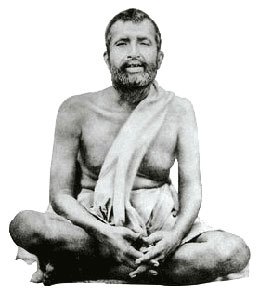
SAI: What is meant by ‘saint’?H: I guess I mean a messenger from God. From the list of ten names, the world thinks of Sankara, Ramakrishna and Ramana Maharshi as being such.SAI: Ramakrishna started as a devotee of God. There was Mother Kali and himself. They were separate. A duality existed. At one point he engaged in a certain action, and Mother Kali never appeared to him again. Towards the end he merged in God and was God-realized.H: Sankara and Ramana Maharshi were similar cases?SAI: Yes.H: Perhaps Buddha was a messenger of God? |
SAI: Buddha never mentioned God. The story is known that he was a prince with wife and child, that when he saw misery and death he determined to find their cause. For years he engaged in severe austerities. He made three announcements: All is suffering. All is transient. All is void.
H: Then Buddha did not realize God but realised nirvana?
The Greatness of Madhura Bhakthi
SAI: Yes. (On a previous occasion Sai had said that one found that for which he sought, and the Buddha had searched for the cause of sorrow).There is only one yoga, and that is bhakthi yoga. All the others, Kriya yoga, hatha yoga, the so-called Sai yoga, pranayama, all the methods and techniques known as yogas belong to the body. They are like drill exercises. Right! Left! Up! Down! Where is the result? They are worthless and a waste of time; Bhakthi yoga is the direct path to God. It is the easy way. All others are useless. There are six types of Bhakthi. Madhura means sweet; this is the highest type.
H: What makes madhura the highest?
SAI: In this the devotee sees everything as God. When Jayadeva would lift his clothes to put on, he would see Krishna in the garments and would not treat them as clothes. He would go about the streets unclothed and people would put a garment around him. He would talk with Krishna, sing to Krishna, dance with Krishna, merge with Krishna, and fall senseless. He was the guru of Chaitanya.
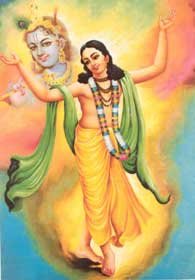
SAI: Jayadeva, Chaitanya, and Ramakrishna are in this madhura stream of bhakthi. Jayadeva saw himself as the bride of Krishna, and because of this his songs are taken by the public with a worldly meaning as being lustful. Whereas, the true meanings, the meanings they had for Jayadeva are quite different. To himself, the heart was the bride. He was the Atma.
Chaitanya’s Madura Bhakthi
H: What kind of person was Chaitanya?
SAI: Chaitanya also would sing to Krishna and dance in ecstasy with Krishna. Once he visited an admirer. He was lodged in a room next to the prayer hall. Whenever food was offered to the 5-metal idol of Krishna, Chaitanya was observed to be eating that same food in his room.
H: His devotion had…
SAI: Chaitanya had Sachananda as a guru at one time. The guru wanted to test the devotion of Chaitanya. He placed a cube of sugar on Chaitanya’s tongue and said to him to keep it there until he returned from the river. At the river, Sachananda bathed, washed clothes, did his singing and was away some two hours. On returning, he found Chaitanya with his mouth still open and the cube of sugar vibrating somewhat, but intact on the tongue without any melting. Realising Chaitanya’s greatness, and that his control of the senses was so complete, he prostrated and declared that Chaitanya was his guru.
Devotion in Modern Times
H: Swami, are there such complete devotees living today, such as Jayadeva and Chaitanya?
SAI: Oh yes, there are. But mostly they contain the devotion within themselves. Sometime it shows and the world judges the person to be of unsound mind. Swami has encountered such devotees, but He does not grant interviews. But the people live filled with joy. There was one such, a rani, a queen, who was encountered a few years ago. It was not appropriate to the situation to grant interview.
H: Is it possible for a Western person to be such a great bhaktha?
SAI: Oh yes, quite possible.
H: But Swami, for an office-holder who has Swami’s work to do in the world, which is the best bhakthi?
SAI: The same.
H: But how could one do work if he were like that?
SAI: It is quite possible to do work and at the same time be the highest bhaktha. It is the feeling that is important, for the work. Even in the case of Jayadeva and Chaitanya, their influence was widespread.
H: Swami, it seems to be the case that from the time of Krishna to Sathya Sai there has been no opportunity…
CONVERSATIONS WITH SAI – PART Twenty Five
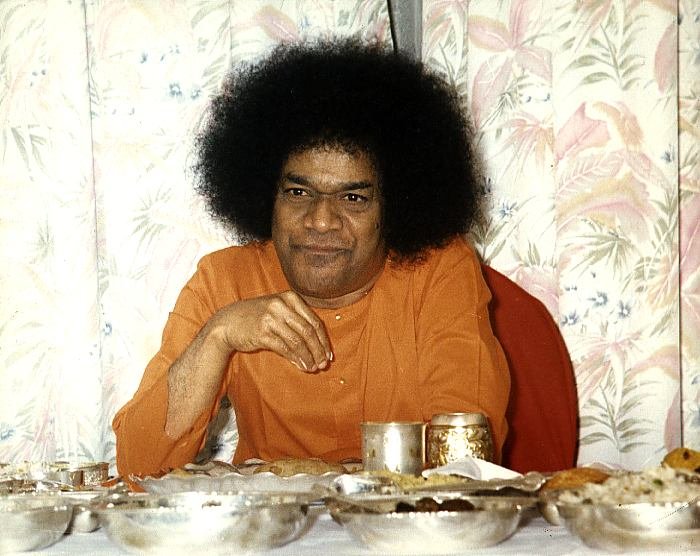
THE GOA INCIDENTH (Hislop): Baba’s dramatic recovery from what the doctors considered as sure death, during the Goa incident, must have amazed and puzzled the doctors?SAI: The next morning, after Baba had at 4 p.m. walked down the 150 steps from the palace to the platform from which He delivered a spiritual discourse, there was a conference of the 25 doctors who had been called by the Governor to consult over Baba, along with quite a number of their medical students. The argument was ‘How could a body with a ruptured appendix and without operation continue to live?’ The top doctor said, ‘We are in a useless discussion. Sri Sathya Sai is divine’. Baba created 25 rings all at once, one for each doctor. They have now all surrendered to Baba, and they call ‘Sai Ram’ before treating any patient. The radio reported Baba as dying. The best doctors in India were called in. Baba was black in colour. The doctors gave Him varying times of up to maximum of ten minutes or so to live. Baba then declared that He would lecture in the afternoon, and that He had taken on the illness of a devotee. India ‘s most prominent doctor said, ‘That may be so, but I say you are about to die.’ Baba said, ‘See at 4 p.m.’STORIES FROM SWAMI’S CHILDHOOD |
Of course, after the immediate retaliation on the boys, they would be loving and affectionate to Baba. Even though Baba had not even a pin for Himself, He would produce pens, pencils, notebook, paper, or whatever the boys needed. This, at length, led to some fear in the village. Because, how could it be explained to the authorities as to how these things were present? At one stage, after the age of 11, Baba was kept more or less out of circulation for a couple of years. At that time the liberation of India was in process, the police were moving in the villages and arresting Congress members, and so on.
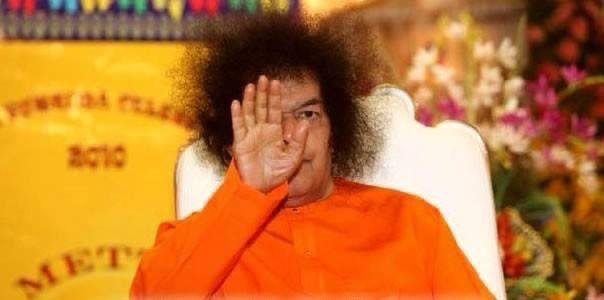
H: The early stories are extraordinary! They do not conform to anything we could imagine. Those childhood companions, they must have been quite special. Was their further destiny unusual also?
SAI: In the school, there were two boys who sat with Swami in the same seat. It was for three. When Swami declared that He would no longer go to school, one boy committed suicide. The other boy went mad. He would call, ‘Raju Raju’ all the time. At length he died.
H: It is very strange. A great mystery. But his death was a good death because his mind was fixed on Swami and constantly calling Swami’s name?
SAI: He merged with Me. There was also a Telugu teacher who took pains to get himself appointed to Swami’s school, and who left the school as soon as Swami left.
THE PLACE OF EXERCISE IN ONE’S LIFE
A Visitor: Is an exercise programme important? In the West, exercise is considered to be of great value.
SAI: Exercise is extolled in the West as a way to digest excess food and sublimate the sex drive. Swami who is completely removed from the area of sensory thoughts, takes a very small quantity of food, and needs no exercise. Yet this body is very strong. For those engaged in work, there is exercise. The idea of exercise comes to those who are idle and who do not have the full responsibility of work. Moderation in life is necessary, otherwise there is no reserve of energy. Food must be in the body for some time for the benefit of the energy reserve. Too much exercise uses up the food energy before it can be added to the reserve. So there is no gain. Likewise, the human system cannot withstand too much talking. One M.P. talked for two hours and felt dizzy. Nobody can continue talking – that is, nobody except Swami who has been doing it for years and years.
H: Swami, hippies are seen wherever one goes. It is difficult for an older person to relate to that sub-culture. It does not seem to express values that can be taken seriously.
SAI: The hippie ideas are based on no work, drugs, begging, and free relationship between the sexes. Baba gave some of them work to do in the print shop. They did not do it. Baba offered funds to go home, they did not want to go. They do not understand ‘karma’, that work produces results, as it is understood in India. Dharma does not have an equivalent word in English. Righteousness is work. Truth in words, and truth and Iove in the heart is dharma.
‘FEEL ANOTHER’S HUNGER AS YOUR OWN’
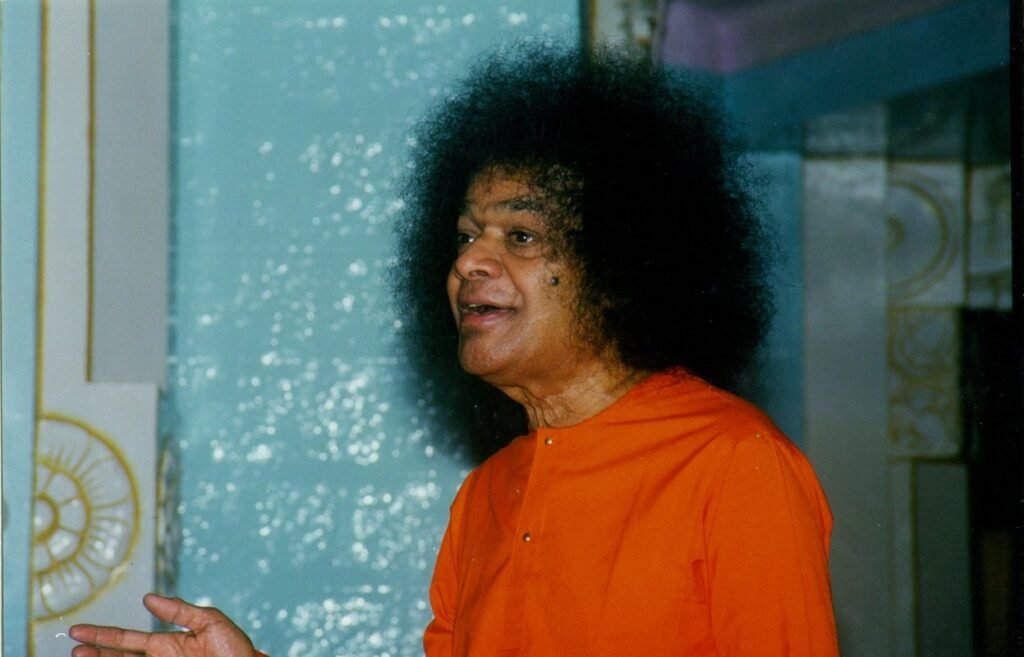
SAI: No, not strange. How would you know the Avathar?
H: By faith.
SAI: Faith is one thing, knowing is another. Your wife may have faith in you, but she does not also know you. The Avathar may be known at one time, but doubt arises and recognition wavers. An example is Viswamitra, the great sage, who asked for the company of the young lads Rama and Lakshmana, to help him overcome the demons who were disrupting his performance of Vedic ceremonies. He said to the King that he did not want the King’s powerful armies, that the two boys, who were divine incarnations, were sufficient. Yet, upon reaching their destination, he called Rama in order to instruct Him in mantras that would overcome the demons. Waves of maya make recognition of the Avathar almost impossible.
H: But Swami, that is still very strange. Recognition of the Avathar was so difficult in those ancient, simpler days, yet in this corrupt and complicated society, recognition of the Avathar is almost world-wide.
SAI: Is it widespread? There are stories and articles about Swami, but how many persons are sure that He is the Avathar, and how many of those who are sure are free of doubt? Another example: you know Swami as the Avathar?
H: Yes.
SAI: No doubts?





















































